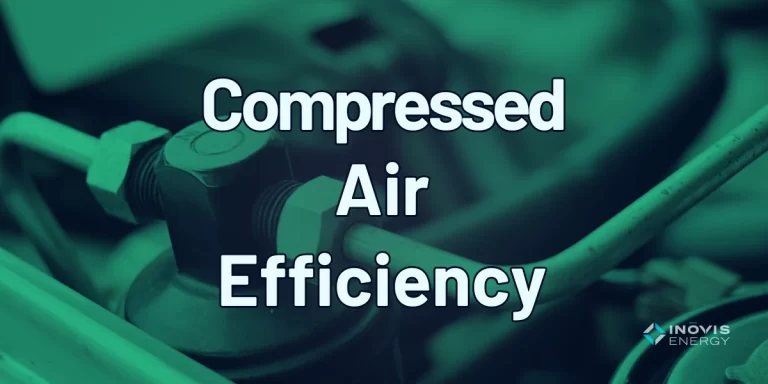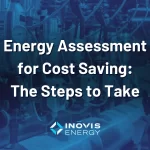Compressed Air Efficiency Upgrades for Industrial and Commercial Systems
Home » Solutions » Energy Efficiency » Compressed Air Efficiency
Compressed air systems are vital in many commercial and industrial facilities—but they’re also notoriously inefficient. This page outlines the most impactful ways to reduce energy waste, lower operating costs, and extend equipment life through strategic compressed air upgrades.
Table of Contents

What is Compressed Air Efficiency?
Compressed air is often called the “fourth utility” due to its critical role in manufacturing, processing, and facility operations. Unfortunately, these systems are also among the most energy-intensive—and in many cases, over 50% of the compressed air produced is wasted due to leaks, improper pressure settings, outdated equipment, or poor system design.
Compressed air efficiency refers to the suite of strategies used to reduce waste and improve performance across the system. This includes:
-
Leak detection and repair
-
Optimizing pressure settings
-
Upgrading or rightsizing compressors
-
Implementing smart controls and VFDs
-
Adding or resizing air storage tanks
-
Recovering waste heat from compressors
-
Redesigning distribution networks
These measures not only reduce electricity consumption but also improve equipment reliability, extend compressor lifespan, and reduce unnecessary maintenance.
Why Improve Your Compressed Air System?
Key Benefits:
-
Cut compressed air energy use by 20–50%
-
Improve equipment uptime and reduce maintenance issues
-
Lower your electricity bill—compressed air is expensive to produce
-
Eliminate waste caused by leaks and over-pressurization
-
Qualify for utility rebates and incentives
-
Extend the lifespan of compressors and tools
-
Improve safety and reduce unplanned downtime
How Compressed Air Optimization Works
Compressed air efficiency is achieved by evaluating and improving how air is produced, stored, distributed, and used.
Key strategies include:
-
Leak Repair: Use ultrasonic or thermal tools to detect and fix leaks that waste energy
-
Pressure Control: Avoid over-pressurizing the system, which increases energy use and wear
-
Compressor Upgrades: Replace oversized or inefficient compressors with rightsized or variable speed models
-
Air Storage: Improve reliability and reduce compressor cycling with properly sized tanks
-
Controls & Sequencing: Use smart controls to manage multiple compressors and adjust output based on demand
-
Heat Recovery: Capture waste heat from compressors to preheat water or air for other processes
How Compressed Air Efficiency Saves Energy
Every pound of pressure above what’s needed adds roughly 0.5–1% more energy use. And a single 1/8” leak can waste thousands of dollars per year.
By targeting:
-
Leaks → Energy waste drops significantly
-
Controls → Compressors run only when needed
-
Storage → Reduces start-stop cycles and extends equipment life
-
Pressure → Optimized for the application, not default settings
Facilities that implement compressed air efficiency projects often see paybacks under 2 years, especially when rebates are factored in.
Industries That Benefit from Compressed Air Efficiency
Manufacturing plants, food and beverage processors, metalworking shops, large maintenance facilities, and any facility using shop air, pneumatic tools, or process air systems.
Any medium to large commercial, industrial, or institutional facility with compressed air demand.
Our Installation Process
Installation Process:
-
On-site Assessment – Inspect compressors, lines, end-use tools, and system controls
-
Data Logging – Capture system pressure and demand profile
-
Leak Audit – Use ultrasonic tools to identify loss points
-
Solution Design – Recommend upgrades based on measured performance
-
Rebate Support – Identify and apply for utility incentives
-
Installation & Verification – Install improvements with minimal disruption and verify savings
Financing Options for Compressed Air Projects
Compressed air upgrades often qualify for generous utility incentives—sometimes covering 50–70% of the project cost. Inovis handles the rebate paperwork and can apply incentives directly to the invoice.
Other options include:
-
On-bill financing or performance-based models
-
Bundled upgrades with lighting or HVAC to create a broader efficiency project
-
“As-a-Service” plans with predictable monthly costs and no upfront capital
Many projects are cash-flow positive from day one thanks to the dramatic energy savings compressed air improvements deliver.
Lower Compressed Air Costs at Your Facility
Compressed air is essential—but it doesn’t have to be wasteful. Inovis Energy can help you assess, upgrade, and optimize your system to save money, improve uptime, and unlock rebates.
